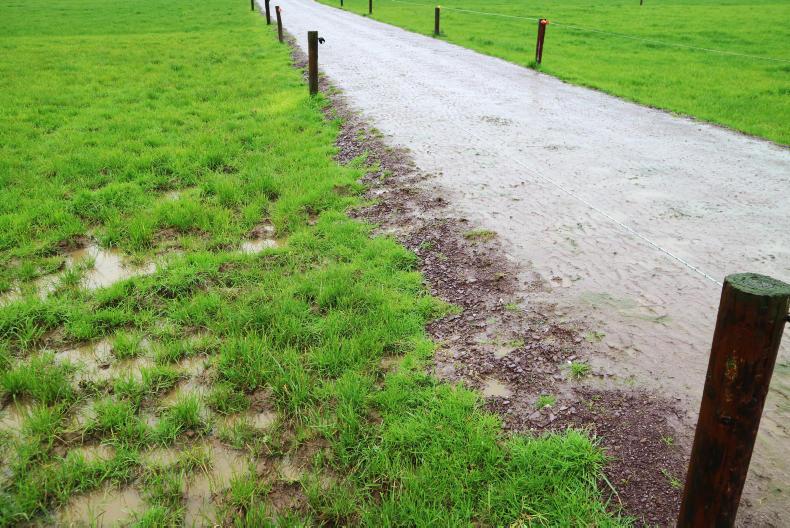August is always a good time to asses and improve grazing infrastructure on-farm. Grazing infrastructure is essential in maximising grass utilization and days at grass.
Good grazing infrastructure should take into consideration:
Animal welfare. Labour efficiency.
Economical efficiency. Environmental perspective.The main areas to look at are paddock layout, roadways and water systems.
Poor roadways are the most noticeable this time of year, as mixed weather conditions can test roadways and highlight problem areas.
Roadways need to be higher than the fields next to them and have a slight camber to allow the water to run off.
Too often, roadways are lower than the fields and/or have a ridge of soil built up alongside them, trapping the water and creating a wet and mucky surface.
Sharp bends on roadways are often an area that cows will stop at, and can become very dirty and messy.
For any heavy soil farm, good grazing infrastructure can lead to an extra month at grass each year
Good cow flow is extremely important to avoiding the build-up of these areas. Replacing right angle turns with more gradual or '50 pence' shaped turns will help with this.
With increasing herd size, another area coming under pressure is the width of the roadways, especially on the main parts of roadways that are travelled daily.
A width of four metres for a 100-cow herd is what’s required. A general rule of thumb from there is an extra 0.5m wide for every extra 100 cows.
Paddock layout and water systems also need to be looked at. Focus on the driest fields on your farm first, as these are the paddocks you will try to graze in wet conditions. These paddocks should meet the following criteria:
A minimum of two entrances/exit points. Long, narrow paddocks that have three or more grazings may need more access points. The maximum depth of a paddock from a roadway should be 250 metres. If this is exceeded, you may need to consider introducing a spur roadway to minimise damage in wet weather.Water access in these paddocks should be set up with strip wire being used in mind. Ideally, a paddock with three grazings would have a water trough in the front third and back third of the field.For any heavy soil farm, good grazing infrastructure can lead to an extra month at grass each year, helping to increasing profitability and reducing labour.
August is always a good time to asses and improve grazing infrastructure on-farm. Grazing infrastructure is essential in maximising grass utilization and days at grass.
Good grazing infrastructure should take into consideration:
Animal welfare. Labour efficiency. Economical efficiency. Environmental perspective.The main areas to look at are paddock layout, roadways and water systems.
Poor roadways are the most noticeable this time of year, as mixed weather conditions can test roadways and highlight problem areas.
Roadways need to be higher than the fields next to them and have a slight camber to allow the water to run off.
Too often, roadways are lower than the fields and/or have a ridge of soil built up alongside them, trapping the water and creating a wet and mucky surface.
Sharp bends on roadways are often an area that cows will stop at, and can become very dirty and messy.
For any heavy soil farm, good grazing infrastructure can lead to an extra month at grass each year
Good cow flow is extremely important to avoiding the build-up of these areas. Replacing right angle turns with more gradual or '50 pence' shaped turns will help with this.
With increasing herd size, another area coming under pressure is the width of the roadways, especially on the main parts of roadways that are travelled daily.
A width of four metres for a 100-cow herd is what’s required. A general rule of thumb from there is an extra 0.5m wide for every extra 100 cows.
Paddock layout and water systems also need to be looked at. Focus on the driest fields on your farm first, as these are the paddocks you will try to graze in wet conditions. These paddocks should meet the following criteria:
A minimum of two entrances/exit points. Long, narrow paddocks that have three or more grazings may need more access points. The maximum depth of a paddock from a roadway should be 250 metres. If this is exceeded, you may need to consider introducing a spur roadway to minimise damage in wet weather.Water access in these paddocks should be set up with strip wire being used in mind. Ideally, a paddock with three grazings would have a water trough in the front third and back third of the field.For any heavy soil farm, good grazing infrastructure can lead to an extra month at grass each year, helping to increasing profitability and reducing labour.






 This is a subscriber-only article
This is a subscriber-only article










SHARING OPTIONS: